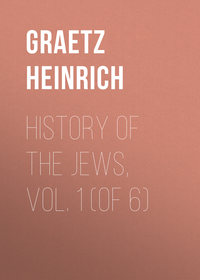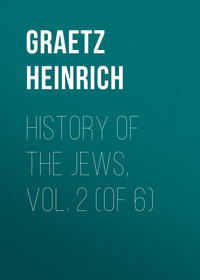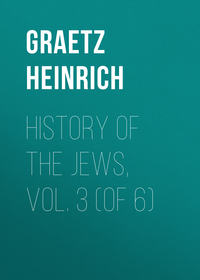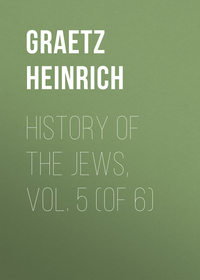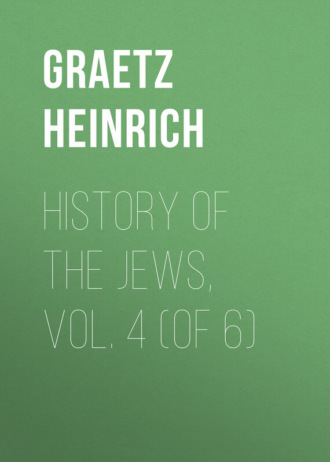 полная версия
полная версияHistory of the Jews, Vol. 4 (of 6)
Chance brought to light the mental treasures of Deï Rossi. Ferrara, where, after leaving Bologna, he had settled shortly before, had been visited by a terrible earthquake (November 18th, 1570), and the inhabitants were compelled to leave their ruined and crumbling houses and seek places of refuge outside the city. In one of the villages Deï Rossi happened to meet a learned Christian, who was trying to overcome the gloomy thoughts caused by the earthquake by reading a Greek book of Jewish antiquity. In conversation Deï Rossi became aware that his co-religionists, even those possessed of some culture, owing to their one-sided absorption in the Talmud or obsolete philosophical writings, knew nothing of their own brilliant literature of the period of the Second Temple, whilst Christians resorted to it to dispel melancholy thoughts. Encouraged by his Christian friend, he determined to translate into Hebrew the "Letter of Aristas," supposed to be the discourse of a Greek king about the wisdom of the Jews, in order to make it accessible to his fellow-believers. He completed this task in twenty days. This was the first-fruit of his learning, and it led him on to further undertakings. His principal work, "Light of the Eyes," consists chiefly of parallel passages from Talmudic and profane sources upon the same subjects. Deï Rossi's distinction rests upon the fact that he did not adhere to tradition, but applied the methods of scientific inquiry to what the multitude regarded as unassailable truths, and that he used profane sources in elucidating them. The actual results of this historical investigation, for the most part, have proved unsound. Strong as Deï Rossi was in removing obstructive rubbish, his power of reconstruction was small.
The value of his efforts appears in its proper light only if we compare them with the circumstances of his time, or with the works of contemporary writers on the same subject, as, for example, those of Gedalya Ibn-Yachya; to these they form a complete contrast.
A descendant of the Italian branch of the noble Ibn-Yachya family, Gedalya inherited taste for knowledge. He was born in 1515, and died in 1587. His wealth enabled him to satisfy his taste by collecting a magnificent library. In his voluntary and compulsory journeys in northern Italy – for he was a preacher, and owing to the intolerance of the popes had to lead an unsettled life – he had seen and read much, both in sacred and profane literature, but without independent judgment, without discrimination, and without appreciation of the essence of truth. Ibn-Yachya's abbreviated "History of the Jews," together with a chronicle of the world, called "The Chain of Tradition," at which he worked for nearly forty years, is a confused medley of authentic historical narratives and mere fables. But in spite, or perhaps because, of its legendary contents, his book has found more acceptance among Jews than the researches of Deï Rossi. When the first edition of the latter's "Light of the Eyes" found its way to Safet, the orthodox of that town declared its contents to be heretical. Joseph Karo commissioned Elisha Gallaico, one of the members of his rabbinical college, to draw up an indictment, to be distributed amongst all Jews, ordering Deï Rossi's work to be burned. The people of Safet likewise had an inquisition. But Joseph Karo died (in Nisan, i. e., April, 1575) before he had signed the indictment. The Italian Jews were not so fanatical as to condemn Deï Rossi, for they knew him to be a pious and pure Jew. But the rabbis of Mantua employed the procedure of Ben Adret concerning the study of profane literature, that is, they forbade the reading of Deï Rossi's works by young people under twenty-five years of age. In consequence of this semi-official sentence of heresy, the book exercised but little influence upon the Jewish world of that day, or the generation immediately succeeding it, and has been appreciated only in quite recent times, when it created a new, enlightened view of history in Jewish circles. But in the Christian world Deï Rossi's work was noticed much sooner, and was annotated, and translated into Latin.
How, indeed, could a sober, critical method of inquiry have found favor in an age when the mystic, dazing Kabbala was the first authority, bidding men esteem blind credulity as the highest virtue, and exciting visionary enthusiasm to the highest pitch of fanatical intoxication? The visions of Solomon Molcho and Joseph Karo and their fond enthusiasm about the Messiah were sober compared with the excitement which reigned after their death, and celebrated a veritable witches' Sabbath. During the last three decades of the sixteenth century the Kabbala gained sole mastery in Palestine, conjured up apparitions, and encouraged orgies of mysticism. It spread thence over the whole of Turkey, Poland, Germany, and Italy, darkening and confusing men's minds, having an evil influence even upon their hearts, allowing no healthy thought to appear, or branding such thought as heretical and sinful. Once again, as in the early days of Christianity, Galilee, especially the district of Safet, became the scene of a host of evil spirits, of people possessed with devils, which challenged mystic exorcism, and revealed profound mysteries; and it is impossible to say whether the possessed appeared in consequence of the exorcisers, or the latter of the former. It was a period of Kabbalistic mania, coincident with profligacy and moral degradation, and its victims despised not only the sciences, but even the Talmud with its exhortations to sobriety. Then for the first time the Jewish world entered on a "dark age" of its own, with all the appropriate credulity, while only the last traces of such darkness were visible in Europe generally. This tendency was exaggerated by two men, who by their fanaticism and visionary extravagance infected a continually widening circle. These were Isaac Lurya and his disciple Chayim Vital Calabrese.
Isaac Lurya Levi (born in Jerusalem in 1534, and died 1572) was descended from a German family. Left an orphan at an early age by the death of his father, young Isaac came to Egypt, to the house of a rich uncle, Mardochaï Francis, a tax-farmer, and began to study the Talmud. The dry study of the Talmud, which filled the mind with voluminous learning, unfruitful hairsplitting, and mere formulas, yet failed to satisfy the wants of the heart, seems to have become repugnant to Lurya, and to have driven him to fantastic mysticism. He preferred the awful loneliness of the Nile country to the noise of the school; abstraction in worlds of mysticism and devout praying to working out intellectual problems. He was greatly attracted by the Zohar, which had then been printed for the first time, and, widely spread abroad, had become accessible to everybody. The more familiar he became with the Kabbala through his absorption in the sounding emptiness of the Zohar, the more did he seek solitude, and the less intercourse had he with men. He even neglected his young wife, only visited his house from Sabbath to Sabbath, and spoke little, that little being only in Hebrew. Lurya is said to have spent several years in solitude in this manner, and the result was that like all whose reason is weaker than their imagination, he became a confirmed visionary. The mystic book, the Zohar, his constant companion in this seclusion, aided in exciting his imagination. Firmly convinced of its authenticity as the work of Simon bar Yochaï, and also of the divine character of all the fantasies and follies therein revealed, Lurya persisted in seeing in it high allusions and profound wisdom. In his heated imagination he even saw Elijah, the teacher of mysteries, face to face.
But what did the prophet Elijah, or the Zohar, or rather his own heated imagination, reveal to him? First he took the trouble to put system, unity, and logical order into the confusion and intricacies of the Zohar, as if connected thought could be expected in the idle chatter of a half imbecile. The hermit of Cairo sought to deduce from it how God had created and ordered the world by means of the mystic numbers (Sefiroth), or how the Godhead revealed itself in the forms of substances, or how it concentrated itself within itself in order to project the finite nature of created things from its own infinitude. Thus he evolved an extraordinarily complicated system of powers and opposing powers, forces and counterforces, forms and degrees (Parsophin), in the four spheres of Separation, Creation, Formation, and Transformation; and he clothed these empty abstractions with such wondrous names, that he afterwards complained, with reason, that no one could understand his mystic system. Yet Lurya looked upon this intricate and complex theory of the creation as only a kind of introduction to what seemed to him a much more important and practical part of the Kabbala, whereby the divine order of the world (Olam ha-Tikkun) could be brought about. This practical Kabbala of Lurya rests upon a not less marvelous doctrine of souls, also based upon the visions of the Zohar.
Our souls, he says, reflect the close connection between the finite and the infinite, and, therefore, have a manifold character. The whole of the soul material to appear in temporal life was created with Adam, but each soul, according to its higher or lower degree, was fashioned in, from, or with the first man, out of high or low organs and forms. Accordingly, there are souls of the brain, the eyes, the hands, and the feet. Each of these must be regarded as an effluence, or spark (Nizuz), from Adam. By the first sin of the first man – for the Kabbala finds original sin necessary for its fanciful creations – the higher and the lower, the superior and the inferior souls, good and evil, became confused and mingled together. Even the purest beings thereby received an admixture of evil and the devilish element of the "husk" (Kelifa). But the moral order of the world, or the purification of the first man, cannot be brought about till the consequences of original sin, the confusion of good and evil, are obliterated and removed. From the most evil part of the soul material emanates the heathen world; the people of Israel, on the other hand, come from the good part. But the former are not quite without an admixture of the original good, while the latter are not free from an admixture of the corrupt and demoniac. This imperfection gives the continual impulse towards sin, and hinders the chosen fragment of the human race from following the law of God, the Torah. The Messianic period will put an end to the disturbance of divine order arising from the first sin, or abolish the disorder which has since crept in, and will introduce, or see introduced, the divinity of the world. Therefore, a complete separation of good from evil must take place, and this can only happen through Israel, if it or each of its members will lose or cast away the admixture of evil. For this purpose, men's souls (especially those of the Israelites) have to wander through the bodies of men and animals, even through rivers, wood, and stones. The doctrine of the transmigration of souls forms the center and basis of Lurya's Kabbala, but he has a peculiar development of the idea. According to this theory even the souls of the pious must suffer transmigration, since not even they are free from the taint of evil; there is none righteous upon earth, who does only good, and sins not. In this way, Lurya solved the difficulty, which former Kabbalist writers could not overcome.
But this separation of the good and evil elements in the world's soul material, the expiation and obliteration of original sin, or the restoration of the divine order in Adam, would require a long series of ages, owing to the impulse towards sin continually present. There are, however, means of hastening this process, and this was the really original doctrine that Lurya enunciated. Besides the transmigration of our souls, sinful and subject to demoniac forces as they are, there is another mode of expiation, the elevation or impregnation of the soul (Ibbur, superfœtatio). If a purified soul has neglected various religious duties here on earth, or has had no opportunity of fulfilling them, it must return to the earthly life, attach itself to the soul of a living human being, and unite and coalesce with it in order to retrieve this neglect. Or again, the departed spirits of men freed from sin appear again on earth to support the weak and wavering souls which cannot attain to good by their own efforts, strengthen them and lead them to the final goal. These pure spirits combine with weaker souls still struggling, and form a union with them, provided that they have some affinity with one another, i. e., if they originate from the same spark or organ of Adam, since as a rule only similar (homogeneous) souls attract each other, while on the other hand dissimilar (heterogeneous) souls repel each other. According to this theory the banishment and dispersion of Israel have for their purpose the salvation of the world or of men's souls. The purified spirits of pious Israelites unite with the souls of men of other nationalities in order to free them from the demoniacal impurities that possess them.
Isaac Lurya imagined a complete system of the transmigration and combination of souls. It also seemed to him important to know the sex of a soul, for feminine souls are found in masculine bodies, and vice versâ, according to the transmigration and attraction in each case. It is especially important in contracting a marriage to know whether the souls of man and wife harmonize with each other in respect of origin and degree. By means of this secret the visionary of Cairo expected to solve the other mystery, namely, how good spirits may be conjured down from heaven, and in a measure compelled to enter the bodies of living men, and thus made to divulge revelations of the world beyond. Hereby he believed that he held the key to the kingdom of the Messiah and the regeneration of the world. Lurya also believed that he possessed the soul of the Messiah of the branch of Joseph, and that he had a Messianic mission. He saw spirits everywhere, and heard their whispers in the rushing of the waters, the movements of the trees and grass, in the song or twittering of birds, even in the flickering of flames. He saw how at death the souls were set free from the body, how they hovered in the air, or rose out of their graves. He held intimate intercourse with the saints of the Bible, the Talmud, and with the rabbis, in particular with Simon bar Yochaï. In short, Lurya was a ghost-seer and raiser of the dead, a second Abraham Abulafia, or Solomon Molcho, arousing hopes of the coming of the Messiah by Kabbalistic jugglery, but with all this fanaticism he was sober and sophistical. He introduced the casuistry of the Talmud into the Kabbala.
In Egypt, Isaac Lurya found little or no favor with his labyrinth of higher worlds and his theories of creation and redemption. To realize his scheme of redemption he migrated with his wife and child to Safet, the Jerusalem of mysticism, where the mystic doctrine flourished, and the Zohar, the spurious work of Moses de Leon, was exalted to the same level as the Law of Moses ben Amram. Almost the whole college of rabbis and the chief leaders of Safet were Kabbalists. This place was at the time a flourishing city inhabited only by Jews. The members of the community knew little of oppression or the cares of life, and so the Kabbalists could spin mystical theories to their hearts' content. They felt as safe under the favor that the Jewish Duke of Naxos found with the sultan, as if in a state of their own, politically independent. The Kabbalists had gone so far in their imitation of Catholicism that they had adopted auricular confession and the adoration of martyrs. And this was the stage on which Lurya, the creator of the new Kabbala, was to originate new aberrations.
At first (about 1569), he appears to have received little attention in the city of Kabbalists. Only through his acquaintance and connection with a still greater visionary, perhaps not quite so honest as himself, did he become a person of consequence, and infect everyone with his waking dreams. This man was the Italian Chayim Vital Calabrese (born 1543, died 1620), whose father, a copyist of the scrolls of the Law, had traveled to Palestine from Italy. Vital had learned nothing thoroughly in his younger days; he had only gained a smattering of the Talmud and mystic lore. He possessed a wild, extravagant imagination, and a decided inclination for adventure and sensation. For two years and a half Vital had occupied his time with alchemy and the art of making gold. From this mystic art he turned to Lurya's Kabbala. It is not known which of these two men first sought the other, but it is certain that each, without wishing it, deceived the other. Together they visited desolate places and graves, particularly the grave of Simon bar Yochaï, the feigned author of the Zohar, in Meïron. This was Lurya's favorite spot, because there he fancied he could draw down upon himself the spirit of this supposed chief of the mystics. Now and again Lurya sent forth his disciple to conjure up spirits, and for this purpose delivered to him certain formulas made up of the transposed letters of the name of the Deity. Of course, evil spirits fled before Vital's gaze, whilst good spirits attached themselves to him, and communicated their secrets.
It was Vital who spread sensational reports concerning the extraordinary, almost divine gifts of his master, and of his power over departed and living souls; doing so, it appears, with an artful calculation of effect and publicity. Lurya, once so isolated, now found himself surrounded by crowds of visitors; Kabbalists, young and old, came to listen to the new revelation. Several disciples attached themselves to him, and he communicated to them his confused thoughts, assigned to each the original Adamite soul that dwelt in him, the transmigrations which it had undergone before its present corporeal existence, and its functions on earth. It never occurred to these people, already enmeshed in the Kabbalistic net, to doubt the truth of these communications. The disciples that gathered round him Lurya formed into two classes: the "initiated" and the "novices."
Mystical conversations and notes, the interviewing and summoning of spirits, formed the occupation of Lurya and his followers. In short, Lurya was on the eve of founding a new Jewish sect. On the Sabbath he dressed in white, and wore a fourfold garment to symbolize the four letters of the name of God. The underlying fact of all his revelations and exertions was that he was the Messiah of the race of Joseph, the forerunner of the Messiah of David's line. This, however, he only furtively hinted to his disciples. His delusion was that the Messianic period would commence at the beginning of the second half of the second period of a thousand years since the destruction of the Temple, i. e., in 1568.
The sudden death of the mystic, at the age of thirty-eight, conduced still more to his glorification. Death is wont to transfigure natures like his, and veneration for them increases as years roll on. With Eastern exaggeration, his disciples regarded him as even more than a worker of wonders; they called him the "Holy and Divine," and sought, for their own glory, to win adherents for him and his visionary extravagances. They declared that, if Lurya could only have lived five years longer, he would have improved the world so effectually, that the Messianic period would certainly have begun. Abraham Abulafia, who had evolved a Kabbalistic medley from his own consciousness, was declared a heretic, and persecuted. Isaac Lurya, who had done the same thing with the Zohar as a foundation, was almost deified.
After Lurya's death, Vital Calabrese came to the fore. He immediately usurped a kind of authority over his fellow-disciples, pretended that Lurya on his deathbed had appointed him his successor, and, in feigned obedience to a dying request of his master, took away from them the written notes given them by Lurya. Vital let it be understood that he was the Messiah of the race of Joseph. However, some disciples did not pay any attention to this, and forthwith taught in various countries what they had received from Lurya himself. This was especially done by Israel Saruk in Italy, whither he had traveled.
The harm that the Kabbalistic doctrines of Lurya caused in Jewish circles is inexpressible. Judaism became surrounded with so thick a husk of mysticism, that it has not even yet succeeded in entirely freeing itself, and showing its true kernel. Through Lurya's influence there was formed, side by side with the Judaism of the Talmud and the rabbis, a Judaism of the Zohar and the Kabbala. For it was due to him that the spurious Zohar was placed upon a level with, indeed higher than, the Holy Scriptures and the Talmud.
The mysticism of Lurya laid stress upon an idea which has been strangely neglected in Jewish circles, viz., devotion in prayer, but even this devotion degenerated into Kabbalistic trifling. Every word and every syllable of the ordained prayers was to be meditated on devoutly, so that one might reflect upon the worlds of the Sefiroth, the number of the names of God hidden therein, and many other things. Lurya's Kabbala certainly inculcated the preservation of an unruffled disposition, and interdicted dejection, or outbreaks of anger and ill-humor. But this serenity, from its mystical setting, received a touch of constraint and unpleasantness, like the laughter of a madman. The Sabbath, with its prayers and meals, forms the central point of Lurya's mystic teaching. He looked upon it as the visible representation of the world of the Sefiroth, as the embodiment of the Divinity (Shechinah) in temporal life, and all actions done or left undone on that day had an influence upon the higher world. Lurya's followers welcomed the Sabbath, "the mystic bride," with chanting, and for this purpose Lurya composed Chaldaic songs full of obscure and meaningless formulas. His Kabbala also introduced a second Day of Atonement. The "Day of Hosannas," the seventh day of the Feast of Tabernacles, was formerly observed as a day of festivity. Even Joseph Karo did not venture in his code to attribute a higher, mystical, religious function to this day. Lurya's school first raised it, on the authority of the Zohar, to the rank of a minor day of expiation, introduced the practice of holding a mystic vigil the previous night, and perceived in every leaf of the willow branches, and in the seven-fold processions round the scrolls of the Law, a higher, mystical meaning. In relation to morality, too, the mysticism of Lurya had a corrupting influence. It demanded a "harmony of souls" as a condition of marriage, and, therefore, whenever disagreement showed itself in married life, it was said that the marriage was not a union foreordained by the harmony of the Sefiroth. Kabbalists, therefore, separated from their wives in consequence of the smallest dissension in married life, to seek out the harmonious soul predestined for them. Thus divorce became frequent in Kabbalistic circles. Kabbalists often left their wives and children in the West, and, migrating to the East, contracted a new marriage, or several new marriages, and the children of the different marriages knew nothing of one another.
These corrupting mystic doctrines did not remain a dead letter, but were forthwith put into practice by their adherents. Thus, the brilliance shed by the Jewish Duke of Naxos and other influential Jews at the Turkish court over their fellow-believers in the East, came to resemble the light of the will-o'-the-wisps that make the waters of a stagnant marsh gleam with a flickering light. The religious stagnation at the time was glaring indeed; there was a complete relapse into heathenism; and what was worse, there sounded no warning voice which recognized the mischief, or stigmatized, though ever so feebly, the corruption as it really was. Perhaps the feeling of complete security in which the Jews in Turkey reposed under mighty protectors of their own race had encouraged this religious disorder. In any case, it did not decrease as this protection gradually disappeared, when the influence of Joseph of Naxos ceased on the death of Sultan Selim in 1574. His successor, Sultan Murad III (1574–1595), left the Jewish duke in possession of his rank and offices according to his father's dying request. But he no longer had direct influence over the divan; he was supplanted by his adversary, the grand vizir, Mahomet Sokolli, and his rival, Solomon Ashkenazi, and could accomplish nothing without intrigues through the agency of the harem. Joseph Nassi did not long survive his partial disgrace; he died of calculus, on August 2d, 1579, sincerely lamented by the Jews. His accumulated treasures melted away even as his ambitious designs. The avaricious sultan, Murad, who slept upon heaps of gold in order that they might not be stolen from him, by the advice of Mahomet Sokolli confiscated all his property, ostensibly to cover his debts. The widowed duchess, Reyna Nassi, with difficulty retained her dowry of 90,000 ducats out of her husband's estate. This noble woman, although she certainly did not possess the spirit either of her mother, Donna Gracia, or of her husband, determined like these to spend her wealth in the interests of Jewish knowledge. She set up a Hebrew printing press in her palace of Belvedere, and afterwards in a village called Kuru-Gismu, on the European side near Constantinople. But she was misled by Joseph Askaloni, a business manager devoid of all taste, to whom she had intrusted the direction of her press, so that only writings of no importance, which had far better have remained in obscurity, were published in her establishment (1579–1598). And so this noble family of two men and two women, renowned in their own time, left no worthy or lasting memorial; and their deeds, prompted by the noblest intentions, have perished in the stream of the ages.


